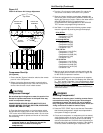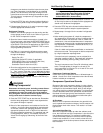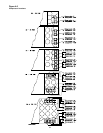
83
Unit Start-Up (Continued)
Note: Do Not release refrigerant to the atmosphere!
If adding or removing refrigerant is required, the
service technician must comply with all Federal,
State and local laws. Refer to general service
bulletin MSCU-SB-1 (latest edition).
7. Verify that the oil level in each compressor is correct. The
oil level may be down to the bottom of the sightglass but
should never be above the sightglass.
8. Press the STOP key at the Human Interface Module in
the unit control panel to stop the system operation.
9. Repeat steps 1 through 8 for the number 2 refrigeration
circuit.
10. After shutting the system off, check the compressor's
oil’s appearance. Discoloration of the oil indicates that an
abnormal condition has occurred. If the oil is dark and
smells burnt, it has overheated because of: compressor
is operating at extremely high condensing temperatures;
high superheat; a compressor mechanical failure; or, oc-
currence of a motor burnout.
If the oil is black and contains metal flakes, a mechanical
failure has occurred. This symptom is often accompanied
by a high compressor amperage draw.
If a motor burnout is suspected, use an acid test kit to
check the condition of the oil. Test results will indicate an
acid level exceeding 0.05 mg KOH/g if a burnout oc-
curred.
The scroll compressor uses Trane OIL-42 without substi-
tution. The appropriate oil charge for a 9 and 10 Ton
scroll compressor is 8.5 pints. For a 14 and 15 Ton scroll
compressor, use 13.8 pints.
Compressor Crankcase Heaters
9 and 10 ton scroll compressors have a 100-watt heater in-
stalled. 14 and 15 ton scroll compressors have two 80-watt
heaters installed per compressor.
Compressor Operational Sounds
Because of the scroll compressor design, it emits a higher
frequency tone (sound) than a reciprocating compressor. It
is designed to accommodate liquids, both oil and refriger-
ant, without causing compressor damage. The following dis-
cussion describes some of the operational sounds that dif-
ferentiate it from those typically associated with a recipro-
cating compressor. These sounds do not affect the opera-
tion or reliability of the compressor.
At Shutdown
When a Scroll compressor shuts down, the gas within the
scroll expands and causes momentary reverse rotation until
the discharge check valve closes. This results in a “flutter”
type sound.
At Low Ambient Start-Up
When the compressor starts up under low ambient condi-
tions, the initial flow rate of the compressor is low due to the
low condensing pressure. This causes a low differential
across the thermal expansion valve that limits its capacity.
Under these conditions, it is not unusual to hear the com-
pressor rattle until the suction pressure climbs and the flow
rate increases.
change any two leads to check the internal motor phas-
ing. If the compressor runs backward for an extended
period (15 to 30 minutes), the motor winding can over
heat and cause the motor winding thermostats to open.
This will cause a “compressor trip” diagnostic and stop
the compressor.
11. Press the STOP key at the Human Interface Module in
the unit control panel to stop the compressor operation.
12. Repeat steps 5 through 11 for each compressor stage
and the appropriate condenser fans.
Refrigerant Charging
1. Attach a set of service gauges onto the suction and dis-
charge gauge ports for each circuit. Refer to Figure 4-6
for the various compressor locations.
2. Open the Human Interface access door, located in the
unit control panel, and press the SERVICE MODE key to
display the first service screen. Refer to the latest edition
of the SAHF-PTG-1B for CV applications or SAHF-PTG-
2B for VAV applications for the SERVICE TEST screens
and programming instructions.
3. Use Table 4-1 to program the following system compo-
nents for the number 1 refrigeration circuit by scrolling
through the displays;
Supply Fan (On)
Inlet Guide Vanes/VFD (100%, if applicable)
OCC/UNOCC Relay (Unoccupied for VAV units)
All Compressors for each circuit (On)
Condenser Fans for each circuit (On)
4. Once the configuration for the components is complete,
press the NEXT key until the LCD displays the “Start test
in __Sec.” screen. Press the + key to designate the delay
before the test is to start. This service test will begin after
the TEST START key is pressed and the delay desig-
nated in this step has elapsed. Press the ENTER key to
confirm this choice.
WARNING
Rotating Components!
Disconnect all electric power, including remote discon-
nects before servicing. Follow proper lockout/tagout
procedures to ensure the power can not be inadvert-
ently energized. Failure to disconnect power before ser-
vicing could result in death or serious injury.
5. Press the TEST START key to start the test. Remember
that the delay designated in step 4 must elapse before
the system will begin to operate.
6. After all of the compressors and condenser fans for the
number 1 circuit have been operating for approximately
30 minutes, observe the operating pressures. Use the
appropriate pressure curve in Tables 4-6 to determine
the proper operating pressures. For superheat and sub-
cooling guidelines, refer to "Thermostatic Expansion
Valves and Charging by Subcooling" at the end of this
section.


















